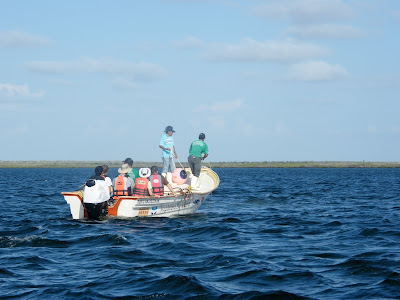23 November 2009
Inspirational Talk by SEE Turtles co-founder Dr. Wallace J. Nichols
17 November 2009
Green Festival Goodies

Just back from the San Francisco Green Festival, billed as the country's largest sustainability event. The show was packed for most of the three days and attendees were bombarded with great speakers, delicious food, and an overwhelming number of green products to choose from.
13 November 2009
Sea Turtle Monitoring and Sea Kayak Expedition, Nov 3-10

A guest post from Melissa Gaskill, who joined a recent turtle research trip to Baja California, organized by Baja Expeditions:
A steep shell beach barely wide enough for a row of tents served as base camp for the most recent SEE Turtles expedition in Bahia Magdalena, near Puerto San Carlos on the Pacific coast of Baja California. Our group included ten tourists, two guides, two cooks, and four pangueros, or boat drivers. Since 2000, local fishermen and conservationists have monitored the sea turtle population here. Once a month, they set nets, check them every two hours, and measure, weigh and tag any turtles caught, then return them to the water. This data measures the effectiveness of efforts to help the endangered animals.

Allowing tourists to participate hands-on in the monitoring not only spreads the word about these efforts, it also provides important financial support.
We first spent three days across the peninsula, at the Baja Expeditions eco-camp on Isla Espiritu Santo, an uninhabited island rising from sky blue Gulf of California waters. There, we snorkeled with sea lions, swam over a shallow reef, hiked a mountain slope bristling with towering cardon, and kayaked from one pristine beach to another, stopping at a mangrove-lined cove along the way. After a night in La Paz, we made a three-hour van ride to San Carlos to board one of Baja’s signature blue-and-white pangas and cross the bay to camp.
Our first order of business: placing the wide-weave, shallow nets across the path of the tide. Julio Solis, a San Carlos panguero (boat driver) who helped establish Magdalena Baykeeper, then pulled out a yellow pad and marked off two-hour shifts from 6 PM that day through 4 PM the next. After he assigned two crew members in each slot, we got our turn to sign up. I chose 8 PM and 4 AM. Neither of those shifts netted a turtle, but the black water reflected bright stars, and I enjoyed helping to check the net by pulling it across the boat, something these men do with practiced ease.
During the day in between shifts, we took outings, one to an isthmus of sand dunes, which we cross to a wide, seemingly endless beach on the Pacific Ocean, and another threading through mangrove channels looking for birds.
In the end, we snagged three turtles, two of them without tags, meaning they haven’t been captured before. The group helped with the data collection and keeping the turtles wet and calm (covering their eyes seems to do the trick). When released, the animals swim away with impressive speed.
Our last day, we wandered the bay, stopping to watch locals fishing with handlines, checking crab traps, and shrimping using an environmentally-friendly slow trawl that skirts but doesn’t drag the bottom. (The previous night, I enjoyed a delicious meal of shrimp caught this way, my first in a long time since giving up shrimp for ecological reasons.) After lunch on a secluded beach in the mangroves, we started the long journey home, all of us, I’m sure, changed by our experience.
The crew from our camp belong to a group of 16 men and women, Cooperativo Eco-Tortuguero de San Carlos, formed to offer this conservation tourism experience. In addition to financing the monthly monitoring, the outings provide an alternative to typical tourism development (think Cancun or Los Cabos), creating dignified work that keeps people in their communities. While many outfitters and destinations claim the ecotourism label, this trip is the real deal.
11 November 2009
Ocean Wildlife Viewing makes people green

Over the years I've seen up close the way sea turtle watching can truly change behavior, from kids to adults, fishermen to artists, even Michael J. Fox changed his life after turtle watching in the US Virgin Islands (see our blog post of May 8, 2009 for more).